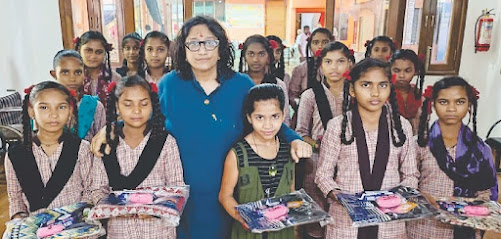DR. MEDHA PHADKE, MBBS, M.D., FIAPM
PAIN IS INEVITABLE, SUFFERING IS AVOIDABLE
DR. MEDHA PHADKE, MBBS,M.D., FIAPM
Breakthrough pain interventionist, anesthesiologist with more than a decade of experience. Visiting pain consultant at Joshi and Ratna memorial hospital, Pune. Visiting pain consultant at Jupitar Hospital, Pune.
What is pain?
Can we avoid it altogether? Simply put, pain is an unpleasant sensation or the 'hurt’ that comes with some injury. It is actually a helpful mechanism designed by nature, so that we stay away from any dangerous object or situation. It is due to the pain that we come to know of any problem in the body or in the environment. For example, if we are exerting too much at work or at exercise, we start experiencing pain in our body which signals us to take a break, rest and re-energise. So pain is inevitable. But sometimes the cause of pain gets removed but the pain continues. We are not able to do our regular activities due to excessive pain. At that point of time, there is no purpose of that sensation and it needs to be treated.
What are the types of pain?
Pain can be classified as acute or chronic, depending on the duration.
- Acute- short term pain, lasting for a few hours to days, usually subsides with or without treatment. For example, twisting of the leg while walking causes acute pain.
- Chronic- long term or persistent pain, usually lasting beyond 3 months. It may be continuous or on-and-off. For example, some people experience headache on-and-off for many years. Most important fact is, if acute pain is not stopped effectively and the cause remains untreated, it may get converted to chronic pain. So acute pain must be stopped in its tracks to prevent long term illness.
Pain can also be classified as-
- Nociceptive- Associated with tissue injury, for example, a paper cut.
- Neuropathic- That due to injury to nerves. There may not be any obvious tissue injury. This is really challenging to treat because while the patient may suffer from terrible pain, on the surface everything usually looks normal. This pain does not respond to usual painkillers. For example, sciatica, diabetic neuropathy, post herpetic neuralgia etc.
How common is chronic pain?
Is it really a big problem? Globally, chronic pain is a common, complex, distressing problem. Around 30%- 40% people are affected due to chronic pain at any point of time. Many people suffering from back pain and neck pain have no option but to take paid or unpaid leaves. Sometimes they are forced to discontinue their work or change their job. Women who experience excessive pain during menses find it hard to work at home or at the workplace every few days a month. For every person who is disabled due to chronic pain, at least one caregiver also has to take out time from work and daily activities. Some people use painkillers, while others just accept their 'fate' and suffer in silence. Some patients consult doctors for their symptoms but that is just the tip of the iceberg, Hence, chronic pain is a huge but undertreated issue.
What are the examples of chronic pain?
Excessive usage of screens and gadgets, lack of exercise, wrong posture for prolonged periods, overweight and obesity, junk food, smoking, excessive alcohol consumption are risk factors for pain. Most of us are likely to experience back or neck pain at some point of time.
- Headache, joints pains are also common.
- With age, knee pain is also common due to wear and tear. Sportspeople are also at risk for sports injuries like tennis elbow, golfer's elbow, ligament tears.
- Cramping pain in the abdomen and back, both related or unrelated to menstruation is also experienced by a lot of women.
- Fibromyalgia is a condition more common in women, in which the patient has widespread pain in the body, sleep disturbances, mood disturbances, digestion problems. Long term diabetes can lead to diabetic neuropathy, frozen shoulder.
- Cancer is also a leading cause of pain. For some patients, cancer pain is very severe and debilitating.
What are the complications of chronic pain?
Chronic pain affects people both physically and psychologically.
- Due to pain in the muscles and joints, patients are unable to exercise. This weakens the muscles and causes even more pain.
- At the same time, pain takes a toll on the mental health. It is associated with anxiety and depression. It causes people to withdraw and socially isolate themselves, which compounds the pain. This affects relationships because the patient cannot spend a good time with family or support the family or enjoy their time with friends.
- Thus, patients usually get caught in the vicious cycle from which they are not able to escape easily.
- Over a period of time, there are long term changes in the nervous system due to which patients' immunity and resilience also reduces, making them susceptible to various illnesses.
How can we get treatment for chronic pain?
Fortunately, chronic pain management is a superspeciality branch of medicine which is dedicated to pain relief and functional restoration. In this type of treatment, the specialists break the patients's 'pain cycle' by various means.
First and foremost, the patients's detailed account of pain is noted. This itself brings about some relief to the patient. ‘Thorough clinical examination is done. A few laboratory tests and imaging tests like X-rays or MRI scans may be done for further evaluation. A diagnosis is reached at and then the treatment is done through various modalities.
- Medicines which are safer to be given in the long run are preferred. These medicines reduce inflammation and act specifically on the pain-signaling nerves to reduce the pain.
- Dry needling, which consists of inserting fine, thread like needles for some time in the painful muscles to repair the injured muscles.
- Nerve blocks and Neuromodulation. These are precise treatments given to pain-signaling nerves, which changes their pain carrying capacity, thereby reducing pain.
- Regenerative therapy like platelet rich plasma (PRP) - This is a novel treatment modality which acts at the root of the problem. It has the potential to reverse the degenerative changes in the muscles and joints. A small sample of the patient's own blood is taken, processed in the PRP machine to extract components rich in growth factors which are injected back into the painful body part. This helps in the healing of sports injuries, ageing conditions like knee pain, back pain etc.
- Psychological treatment to manage the associated anxiety and depression may be given if necessary.
- Physiotherapy- Once the pain is brought under control by using the above treatments, the patient undergoes a stepwise protocol for further prevention of pain.
The key highlights are-
- Fully non surgical treatments are used. There are no scars, no stitches, no bleeding after the procedures.
- The procedures are done within less than an hour.
- Throughout the procedure, the patient is comfortable and communicating with the doctor.
- The patient can walk home on the same day.
- Admission is not required. Pain relief starts immediately for most of the patients.
- There is no bed rest/ dependance on caregivers for the sake of these procedures.
I am suffering from chronic pain. Is chronic pain management really a good option for me?
These treatment modalities are customized for each patient as per the diagnosis and patient's preference. Hence, it is very convenient for patients to get treatment for chronic pain. Till recently, many of these advanced treatments were only available abroad and were very expensive. But nowadays, with huge progress in the healthcare sector, they are now available at select places in the country.
Due to my passion to alleviate suffering due to pain, I have dedicated my time working in this field. Let me describe a few cases which I encountered in my practice.
Case scenario 1 - Cancer pain
Mr. SJ, 60 years old patient was in excruciating pain due to prostate cancer. He had stopped chemotherapy, radiation due to intolerable side effects. He was depressed and contemplating suicide. The whole family was affected. Birthdays and anniversaries were not being celebrated. He had seen multiple doctors for this problem, but had no solution. He had lost hope in the medical system and in life, in general. His daughter attended one of my webinars about public awareness about pain management and reached out to me for this problem.
Tused our characteristic non surgical pain management program for this patient which included medicines, needle based treatments, psychological interventions, physiotherapy, improved ergonomics, family sessions over a period of a few weeks. From the 1st consultation itself, the patient saw a ray of hope. Within a few days his pain reduced. He transformed from being bedridden and suicidal to being happy and independent in his daily activities. His family is very happy. Good news is he is now planning his daughter's wedding.
Case scenario 2 - Back pain
Mrs. SA, a 47 years old patient was suffering from low back pain since 10 years. She had undergone spine surgery three times. However, much to her agony, her pain had compounded every time. She was exasperated and helpless. She could not do her daily household work. Her husband did wfh to support the family and also did the household work. The teenage daughters witnessed all this and missed and longed for the happier times of the past.
When this patient consulted me, I treated her with our special triad of non surgical interventions, psychological counselling, physiotherapy.
Today, with her pain under control, she is able to do the all the activities she wanted to do. She is the proud matriarch, a role that her daughters want to emulate.
Case scenario 3- Knee pain
Mrs. PH, a 60 years old patient who had pain in both her knees while walking. She was advised knee replacement surgery but was not fit for surgery due to multiple health issues, which were a concern for her. Her main concern was that she yearned to play with her 3 year old granddaughter but was not able to do so. I treated her with our signature non surgical treatment and physiotherapy protocol, after which her pain was controlled. She was super joyful and pain free when she brought her granddaughter in the next visit to meet me!
Case scenario 4- Neck pain
Mr. AJ, A 27 years old IT professional was suffering from nagging neck and shoulder pain. He had to work long hours at a desk job. He had tried doing exercise and taken several medicines, without any relief. He was considering changing his stressful job. After treatment with our precise non surgical pain management intervention and lifestyle modification, his pain subsided and he could manage to do his work successfully. With this nonsurgical method of pain management, [ have treated numerous patients and transformed their lives from suffering to one of harmony. At times, our team was financially supported and that helped us reach to a larger number of beneficiaries.] am grateful that I got the opportunity to steer their lives to normalcy and make a difference.





Comments
Post a Comment